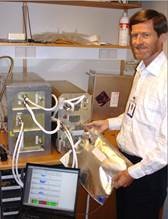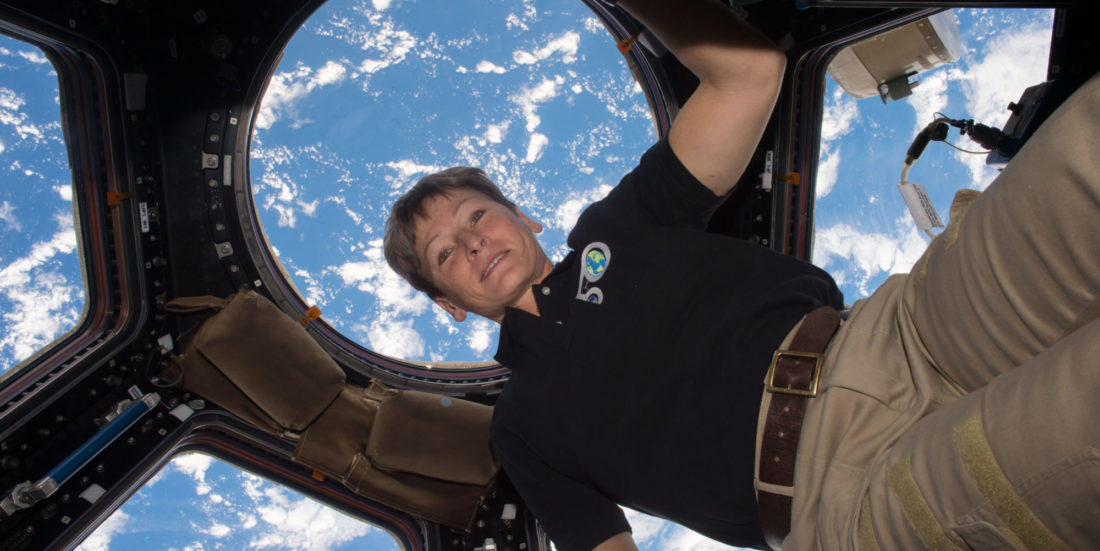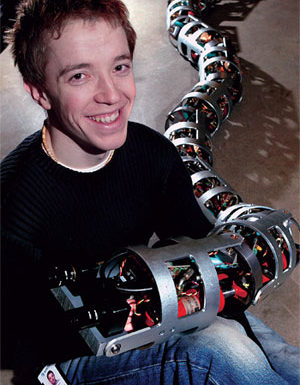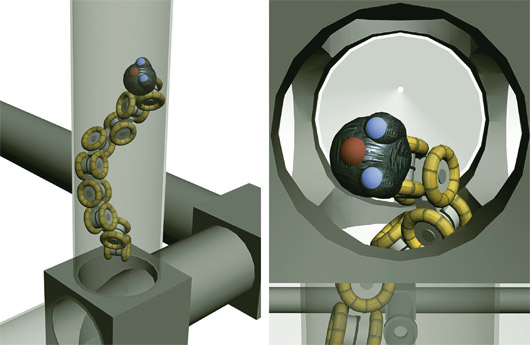The astronaut’s extra nose
How do we protect astronauts in space from breathing dangerous gases? A German-Norwegian hi-tech optical gas sensor provides a solution.
Astronauts need the earliest possible warning if harmful or noxious gases somehow contaminate the air they breathe. “In space you can’t just open a window to ventilate the room,” says Atle Honne, SINTEF senior scientist.Facts about the gas measurement system ANITA

The ANITA gas measurement system automatically analyses air near the instrument. However, air samples can also be collected from other places and fed to the equipment unit in gas bags, as demonstrated by Atle Honne, one of the system’s developers. Photo: Jan Helstad/SINTEF
As a child Honne read everything he could lay his hands on about the stars. Fifty years later, some of his life’s work is being applied in the great expanse of outer space – 400 kilometres above the surface of the Earth. Honne is one of the architects behind a gas measurement system called ANITA, which was tested on the International Space Station (ISS) as an air monitoring system in 2007 and 2008.
The European Space Agency (ESA) has now commissioned a new, more compact and advanced version of the system to be demonstrated and used on the ISS. The plan is to eventually put the technology to use on future manned expeditions further out in space.
Early warning
Scott Hovland is head of the ESA’s ISS Facility and Technology Unit and has been impressed by how quickly the ANITA technology makes measurements.
“It’s essential for astronauts to get an early warning if their air is contaminated by gas leaks or air purification system failures, so they have time to do something about it,” he says. “And the ANITA technology can detect gases that we never expected to find in the space station’s life support system. Its ability to do this is extremely important.”
Mammoths and mice
The instrument itself was developed OHB System AG in Germany, while Atle Honne and his co-workers at SINTEF developed the method the system uses to interpret the data it collects.
The ANITA technology relies on optical measurements to identify gases. It can detect and distinguish between different gases by measuring how much infrared radiation they absorb. The new version of the sensor to be deployed on the ISS will complement existing monitoring systems, which use gas chromatography and mass spectrometry.
The biggest challenge in monitoring indoor air quality is identifying and measuring individual gases out of a complex mix. The optical technique used by ANITA provides faster and far more precise answers than current technologies in analysing complex mixtures, Honne said.
“This doesn’t mean that it’s easy to measure lots of gases at the same time,” he said. “We’re looking for both mammoths and mice, and often the mouse will be hiding behind the mammoth.”
In space in three years
A decade ago, the first version of ANITA passed its field test with flying colours on the ISS, where it was installed by the American space agency NASA. Honne said the system proved that it could measure many gases at the same time – fast and very accurately.
“During ANITA’s year in space, our technology proved that it could ‘see’ gases that other instruments failed to detect,” he said.
The new version of the sensor will be developed by the Norwegian and German team that built the first model. The plan is to have it ready for the ISS in 2020.
Fly me to the Moon
The ESA also intends to use ANITA on possible future space laboratories located in orbit around the Moon – which is nearly 400,000 kilometres from Earth.
Scott Hovland at ESA says that effective air monitoring will be essential when astronauts are so far away. If there are serious problems with their spacecraft, the astronauts in orbit around the Moon can’t simply return to Earth, which is always a possibility for the ISS crew.
“But adequate monitoring is just as important on the ISS,” says Hovland. “It’s important to prevent false alarms. If a false alarm forces the astronauts to evacuate the space station, not only will it waste a lot of money for nothing, but the astronauts will have to undertake the risk of leaving the station for no reason.”
This is among one of the most important reasons why the ESA has chosen to invest in ANITA.
Potential here on Earth
SINTEF’s Honne points out that there are also many potential applications for the high-flying ANITA technology here on Earth. The system can be used to check air quality in everything from submarines and aeroplanes to diving systems and laboratories. He says ANITA is ideally suited to monitoring industrial processes and environmental gas emissions, including waste gases from the agricultural sector.
“The space sector is interesting to us at SINTEF because it is a demanding market,” he said. “If our measurement method passes the test in space, it will be well qualified for applications here on Earth.”





